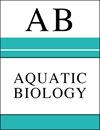The effect of fipronil exposure on the activity of biotransformation enzymes and histology in the liver of grass carp
IF 0.8
4区 生物学
Q3 MARINE & FRESHWATER BIOLOGY
引用次数: 0
Abstract
ABSTRACT: Fipronil (FPN) is an insecticide used in agriculture. This study focused on the biotransformation process and the histopathological effects of FPN in the liver of grass carp. Fish were exposed to environmental concentrations of FPN (3, 6, and 10 ug l-1) for up to 14 d. The alterations in phase I and II biotransformation enzyme activity (ethoxyresorufin-O-deethylase [EROD] and glutathione-S-transferase [GST]), malondialdehyde (MDA) content, and histopathology in the liver were studied on the 1st, 3rd, 7th, and 14th days. Results showed that EROD (dose-dependent) and GST activity (time-dependent) increased. The MDA content increased in a time- and dose-dependent manner. The most common types of hepatological damage were steatosis, vein dilatation, pyknosis, and increased melanomacrophage centers, probably due to oxidative stress originating from biotransformation enzyme activity (R2 = 0.88 for GST and MDA). The degree of tissue change (DTC) at the highest dose indicated moderate damage to the liver (R2 = 0.82 for GST and DTC). Nevertheless, the level of EROD and GST activity and MDA content indicated complex interactions among various phase I and phase II biotransformation enzymes which should be investigated in future studies with more replications.氟虫腈对草鱼肝脏生物转化酶活性和组织学的影响
摘要:氟虫腈(FPN)是一种用于农业的杀虫剂。本研究主要关注氟虫腈在草鱼肝脏中的生物转化过程和组织病理学效应。研究了第 1、3、7 和 14 天草鱼肝脏中 I 期和 II 期生物转化酶活性(乙氧基甲磺酰-O-脱乙基酶 [EROD] 和谷胱甘肽-S-转移酶 [GST])、丙二醛 (MDA) 含量和组织病理学的变化。结果表明,EROD(剂量依赖性)和 GST 活性(时间依赖性)增加。MDA 含量的增加与时间和剂量有关。最常见的肝损伤类型是脂肪变性、静脉扩张、脓毒血症和黑色素细胞中心增加,这可能是由于生物转化酶活性引起的氧化应激所致(GST 和 MDA 的 R2 = 0.88)。最高剂量下的组织变化程度(DTC)表明肝脏受到了中度损伤(GST 和 DTC 的 R2 = 0.82)。不过,EROD 和 GST 活性水平以及 MDA 含量表明,各种 I 期和 II 期生物转化酶之间存在着复杂的相互作用,这一点应在今后进行更多重复的研究中加以探讨。
本文章由计算机程序翻译,如有差异,请以英文原文为准。
求助全文
约1分钟内获得全文
求助全文
来源期刊

Aquatic Biology
生物-海洋与淡水生物学
CiteScore
2.70
自引率
0.00%
发文量
7
审稿时长
3 months
期刊介绍:
AB publishes rigorously refereed and carefully selected Feature Articles, Research Articles, Reviews and Notes, as well as Comments/Reply Comments (for details see MEPS 228:1), Theme Sections, Opinion Pieces (previously called ''As I See It'') (for details consult the Guidelines for Authors) concerned with the biology, physiology, biochemistry and genetics (including the ’omics‘) of all aquatic organisms under laboratory and field conditions, and at all levels of organisation and investigation. Areas covered include:
-Biological aspects of biota: Evolution and speciation; life histories; biodiversity, biogeography and phylogeography; population genetics; biological connectedness between marine and freshwater biota; paleobiology of aquatic environments; invasive species.
-Biochemical and physiological aspects of aquatic life; synthesis and conversion of organic matter (mechanisms of auto- and heterotrophy, digestion, respiration, nutrition); thermo-, ion, osmo- and volume-regulation; stress and stress resistance; metabolism and energy budgets; non-genetic and genetic adaptation.
-Species interactions: Environment–organism and organism–organism interrelationships; predation: defenses (physical and chemical); symbioses.
-Molecular biology of aquatic life.
-Behavior: Orientation in space and time; migrations; feeding and reproductive behavior; agonistic behavior.
-Toxicology and water-quality effects on organisms; anthropogenic impacts on aquatic biota (e.g. pollution, fisheries); stream regulation and restoration.
-Theoretical biology: mathematical modelling of biological processes and species interactions.
-Methodology and equipment employed in aquatic biological research; underwater exploration and experimentation.
-Exploitation of aquatic biota: Fisheries; cultivation of aquatic organisms: use, management, protection and conservation of living aquatic resources.
-Reproduction and development in marine, brackish and freshwater organisms
 求助内容:
求助内容: 应助结果提醒方式:
应助结果提醒方式:


